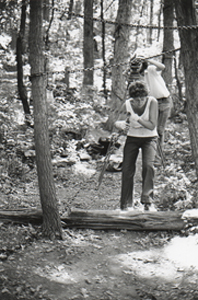
Born in 1931 in Budapest (HU)
Lives and works in New-York (US)

1977/2012
39 photographs of archive, black & white, diagram, text
20,32 x 25,4 cm chacune
Year of Purchase: 2011
“Actual space is intrinsically more powerful and specific than paint on a flat surface.” 0
“I consider life itself to be an instinct for growth, for endurance, for the accumulation of force, for power: when there is no will to power, there is decline.” 01
Agnes Denes is an American artist who was first associated with the Conceptual Art movement before she pioneered Land Art. In the late 1960s, she pushed its boundaries in the direction of Ecological Art which covered everything from individual creation to social awareness—a Rousseaudian 1 “eco-logical” esthetic confronting environmental issues. She drew on scientific culture 2 and on the dynamism of contemporary art. 3 Art and Science, both vectors of human knowledge and experience, joined forces to counter an anthropocentric civilization which turns its back on nature—a civilization founded on a suicidal, progressivist idea of nature’s exploitation. It is no longer just a question of landscape as representation, but of Nature itself. The artist intervenes on the site through performances. She develops a singular metaphor of growth —a movement of life and permanent evolution.
The work Rice/Tree/Burial today takes the form of:
— an interplay of photographs, chronicling the realization of each of the four acts of the work;
— a triangular diagram design—the concept of triangulation in Denes’s work is a visual philosophy which makes it possible to leave behind the classical idea of opposition;
— a publication of a text by the artist, freely interpreting the project in a poetic form.
However, Rice/Tree/Burial is above all a work on the scale of nature, the first public eco-logical performance realized by the artist since 1968 in Sullivan county, then repeated starting in 1977 at ArtPark 4 near Niagara Falls.
Rice/Tree/Burial brings together three Labors 5 composing an allegoric trinity of a cycle of Life 6.
In the first act, the artist planted half an acre of rice. It was a creative process, a metaphor for the nourishing Earth—a maternal figure which naturally engenders life and matter.
The second act radically contrasts with the first. The artist chained some trees within triangles in order to contain their growth. The trees adapt to forces external to the forces of nature, and in the end their tops meet. Trees are a symbol of the regeneration of the Earth, of the power of nature and destiny, trees of life whose natural growth is curbed by the chains of existence and the human will to dominate as the “master and owner of nature.” 7
The third act was the elaboration of a memorial, a buried “time capsule” which must not be opened for a thousand years. It contained haikus handwritten by the artist—conceptual poetry touching on a formalist problematic. In its second version, the capsule contained a microfilm of different responses to an evolution questionnaire which the artist had circulated on the occasion of her guest appearances at universities around the world 8. This final act represented civilization: the invisible roots of our world rising out of another form of culture—they constitute our language, our knowledge, writing, science, abstraction… that is, the locus that brings us together, the missing link between the first two acts, which in turn is a link between the past, the present and the future, between life and death and life.
Luc Jeand’heur
0 Donald Judd, Specific Objects, 1965
01 Friedrich Nietzsche, The Anti-Christ (1888), trans. Judith Norman, in: The Anti-Christ, Ecce Homo, Twilight of the Idols, and Other Writings, edited by Aarond Ridley and Judith Norman (Cambridge University Press 2005).
1 It is in human nature to have the need for nature.
2 Exact sciences, natural sciences, social sciences dealing with Humans, human history, behavior, language, sociology, psychology, and politics.
3 Freedom, critical thinking, poetry.
4 A park dedicated to performing and visual arts, located in Lewiston, NY.
5 This word brings to mind the Labors of Hercules—an extraordinary, lengthy task, at once mythical, iconographical, and symbolic.
6 In Art Park, the artist added a fourth step dedicated to the forces of nature and, for seven days, filmed from a steep ledge overlooking the Niagra Falls.
7 René Descartes.
8 For example: “What would you say the human purpose is?”, “If we are results of a development, in what direction is that development moving?”, etc.